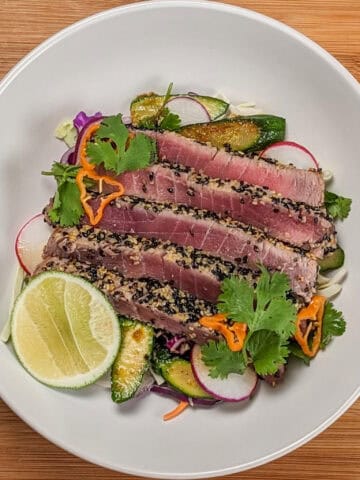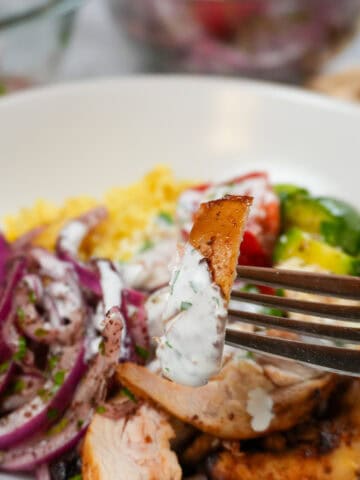Nongshim's Beef-Flavored Seaweed Ramyun with its chewy green noodles and kelp in their smooth, zesty broth with the addition of a poached egg, spicy Korean pepper paste, and sliced cremini mushrooms, then topped with fresh scallions and sesame seeds.

Table of Contents
Jump to:
- I <3 South Korea
- What Is South Korean Food?
- A Reason for That
- Key Ingredients You’ll Love
- Influences on Korean Cuisine
- A Little Korean Cuisine History
- Ingredients with Steps
- Culinary Glossary
- What's inside?
- Substitutions
- Where to Purchase O'Food's Seaweed Ramen?
- Variations
- Equipment
- Storage
- Cooking Tips
- Frequently Asked Questions
- East Asian Recipes
- Soup Recipes
- 📖 Recipe
- Subscribe to My YouTube Channel
- Have a Comment or Question?
I <3 South Korea
I have a special place in my heart for Korean cuisine. Something about it brings comfort; most dishes are spicy, nutty, tangy, or earthy. You get combinations from pickles, well-seasoned vegetables, seared meats, seafood, and smooth and creamy tofu to chewy noodles or sticky warm rice.
They make unique hot foods and cold noodle dishes, which not many other cultures specifically consider for the summer.

Are you looking for authentic Korean recipes? Check out Stella-n-Spice and My Korean Kitchen.
What Is South Korean Food?
South Korean cuisine, or hansik, is like a heartfelt story on a plate. It's bold, vibrant, and packed with flavors that make your taste buds dance to K-pop style. At its core, Korean food thrives on harmony—balancing spicy, sweet, sour, salty, and umami in ways that will leave you dreaming of your next meal.
Korean food isn't just about kimchi (though, let’s be real, it’s a superstar). It's about layers of flavor and textures: tender meats, crisp pickled veggies, chewy noodles, silky tofu, and that satisfying crunch of perfectly charred rice from a dolsot bibimbap.

Plus, Korea's love for seasonal ingredients means dishes are tailored to what nature provides, from a refreshing bowl of naengmyeon (cold noodles) in summer to a hearty stew-like kimchi jjigae (my favorite!!) in winter.
A Reason for That
This is my opinion and why I love K-Dramas, but there is a reason to eat for every occasion. I don't usually see that in other shows. If you go on a picnic, there’s a kimbap, cooked rice and seaweed roll. And if you're chilling with your girlfriends at the local convenience store, there’s Jumeokbap, stuffed rice balls, for that.
In addition, If it's your birthday, there's Miyeok Guk, beef and seaweed soup. Similarly, if you celebrate a long work day and treat your co-workers, there’s Kimchi-Jigea, kimchi tofu stew, then Kimchi rice. And for those hot summers near the beach in Busan, there's Milmyeon, noodles in a chilled broth, for that.
On top of that, an adult girl reconnecting with her sister, there's Samgyeopsal with Seamjang, pork belly with gochujang sweet and spicy paste mix, and perilla leaves, for that. And when I had a rough day, there was Dolsot Bibimbap, a hot stone rice dish with vegetables and beef, for that.

Samgyeopsal is the best! I still remember the first time. It was love at first site! Lol. Seamjang is also a flavorful Korean dipping sauce made by mixing gochujang (red chili paste) and doenjang (fermented soybean paste), often blended with sesame oil, garlic, and green onions. It's commonly served with grilled meats like samgyeopsal (pork belly), as mentioned, and is used to enhance wraps with perilla leaves or lettuce. So good!
Indeed, the list can go on indefinitely: Korean Army Stew, Seafood Stew, Kimchi Pancake, Cold Soba Noodles, Bulgogi! Thus, this post doesn't do Korean food justice. I'm obsessed! Additionally, this is from my point of view, but I would love to hear your thoughts on Korean Cuisine.

Key Ingredients You’ll Love
If you're new to Korean cooking, get ready to stock your pantry with some essentials. Start with gochujang, the sweet and spicy red chili paste that brings the heat, and gochugaru, the chili flakes that make kimchi sparkle.
Add soy sauce, sesame oil, doenjang (fermented soybean paste), and rice vinegar to the mix, and you've got the foundation for most Korean dishes. Don’t forget gim (dried seaweed), perilla leaves, and the all-important short-grain rice that’s so delightfully sticky it practically hugs you back.
Recommended Brands to Start
-
Buy Now$9.80
We earn a commission if you make a purchase, at no additional cost to you.
04/15/2025 07:30 am GMT -
Buy Now$18.60
We earn a commission if you make a purchase, at no additional cost to you.
04/14/2025 08:39 pm GMT -
Buy Now$8.99
We earn a commission if you make a purchase, at no additional cost to you.
04/15/2025 05:00 am GMT -
Buy Now
$8.39$8.00We earn a commission if you make a purchase, at no additional cost to you.
04/15/2025 04:59 am GMT -
Buy Now$29.99
We earn a commission if you make a purchase, at no additional cost to you.
04/15/2025 07:26 am GMT -
$13.39Buy Now
My Rating: ⭐⭐⭐⭐⭐
Purchased: January 03, 2021
My Review: The Nishiki Premium 7 Grains Mix is my go-to bag of multigrain rice when I want that hearty, nutty Japanese or Korean-style multigrain rice without the hassle of blending it myself. It’s incredibly convenient, especially on busy weeks when I don’t have time to swing by the Korean market to stock up on grains. I chose this mix because I’ve trusted Nishiki for years—I’ve used their medium grain and sushi rice even back when I worked professionally in commercial kitchens. The quality is always consistent, and the flavor and texture of this multigrain mix hold up beautifully in everything from rice bowls to bento lunches. It’s a pantry staple I never let run out.
We earn a commission if you make a purchase, at no additional cost to you.
04/14/2025 01:25 pm GMT -
Buy Now$6.73
We earn a commission if you make a purchase, at no additional cost to you.
04/15/2025 05:10 am GMT
Influences on Korean Cuisine
South Korean food is like a well-traveled friend—it's got stories from China, Japan, and even the United States tucked into its recipe book.
Take jajangmyeon, a noodle dish with black bean sauce that’s rooted in Chinese cuisine, or kimbap, which some say evolved from Japanese sushi but with a Korean twist (because more is always better, right?).
Even Korean fried chicken (the other KFC) owes a nod to American influences during the 20th century, but trust me, they took it and made it their own. The result? The crispiest, juiciest chicken with sauces that deserve a standing ovation. My fave? Spicy Garlic Soy with Snow Sauce, creamy onion sauce with raw sliced onions, and pickled daikon!
A Little Korean Cuisine History
Historically, Korean cuisine has been shaped by its agrarian (aka agricultural) roots and the need to preserve food. Fermentation became the MVP, giving us kimchi, gochujang, and a whole lineup of banchan (side dishes) that steal the show.
During the Joseon Dynasty, the royal court turned food into art, crafting elaborate meals that showcased Korea’s rich resources. But don't worry, you don’t need a throne to enjoy these dishes—just a bowl of rice and a good appetite.
So, if you're slurping up seaweed ramyun or indulging in a spicy bowl of tteokbokki (chew rice cakes), South Korean food is all about comfort, creativity, and, most importantly, joy. Let's hear it: What’s your favorite Korean dish? Or better yet, which one are you trying next? 💖
More Korean-Inspired Delights
Are you looking for more ramyun goodness? Check out Quick and Easy Veggie Ramyeon and Sweet and Spicy Seafood Neoguri with Mushrooms, Spinach, and Fried Egg. If you love Korean cuisine, try these Korean-inspired recipes: For an easy, warm rice bowl, check out the Salmon Sesame Chili Rice Bowl.
Undoubtedly, Korean-Style Beef Short Ribs with Smashed Sweet Potato and Hibachi-Style Vegetables is a great Trader Joe's easy meal idea. And finally, if you are a big fan of KFC, Korean Fried Chicken, then you must check out the Sweet and Spicy Gochujang Chicken and Broccoli Stir-fry with Scallions Radish Salad post.
Ingredients with Steps
Get your hands on Nongshim's Soo Air Dried Noodles: Beef Flavor with Seaweed. Moreover, I think the concept of this ramyun was influenced by Miyeok Guk, a beef and seaweed soup.
To begin with, use a small sauce pot. However, there is a golden Korean ramyun pot for instant noodles made from aluminum, which is not suitable for this dish. Those pots are for cooking soups, not sauteeing; they are too thin.
Heat the oil in the saucepan, and brown the mushrooms and scallions (aka green onion). Then add the gochujang and tomato paste, combine well, and continue browning the mushroom mixture. This will also help develop a deep, rich flavor.
Afterward, add the water to deglaze the pan and release the brown goodness from the bottom of the pan. Then, add all the contents from the ramyun packet and chili flakes when the broth boils.
Bring this to a boil again, then add the egg, poaching in the ramyun liquid for about a minute. Finally, pour it into a bowl and garnish it with sesame seeds and green scallions.
Culinary Glossary
This section provides concise definitions of key ingredients and techniques to enhance understanding and improve cooking skills related to this recipe.
Ingredients
- Avocado Oil - A neutral-flavored oil with a high smoke point, perfect for sautéing and frying without breaking down under high heat. Or choose your own oil.
- Cremini Mushrooms - Also known as baby bellas, these mushrooms are a smaller, younger version of portobellos, offering a mild, earthy flavor. Add thinly sliced shitake for a meaty texture.
- Scallions - Also called green onions, these are long, thin onions with a mild taste, often used as a garnish or flavor enhancer.
- Tomato Paste - A concentrated paste made from cooked and reduced tomatoes, adding depth and umami to dishes.
- Gochujang Paste - A Korean fermented red chili paste made from chili powder, glutinous rice, soybeans, and salt, providing a spicy, slightly sweet flavor. Adds the perfect kick of heat.
- Nongshim's Soo Air Dried Noodles Beef Flavor with Seaweed - A popular Korean instant noodle brand featuring chewy green noodles and a rich beef and seaweed broth flavor.
- Red Pepper Chili Flakes - Dried and crushed red chili peppers used to add heat and spice to dishes.
- Black Sesame Seeds - Small, nutty-flavored seeds often used as a garnish, providing a subtle crunch and a hint of earthiness. Fun Fact: Black sesame seeds are black because of the presence of melanin pigments in their hulls (or seed coats).
- Kelp - A type of seaweed often found in Korean and East Asian cuisine, providing umami and a slightly briny flavor to broths.
Technique
- Ramyun - A Korean-style instant noodle, typically spicier and chewier than other types of instant noodles.
- Poaching - A gentle cooking method where food is cooked by submerging it in liquid at a low temperature, ideal for eggs to maintain a soft texture. Learn how to poach eggs.
For quantities, please see the seaweed ramyun recipe card.

What's inside?
First, if you see the words "air dried" on the instant noodle package, that is a good choice. Learn the difference between air-dried and fried noodles in the FAQ section. Air-dried noodles are healthier with fewer calories.
The general ingredients for flavor you will find in the noodles and soup packet package are enriched wheat flour, dried seaweeds (I believe are wakame seaweed), beef bone extract, sesame oil, soy sauce, onion, and garlic.
Furthermore, if you have allergies, just be aware that this product is made in a facility that handles fish, milk, eggs, nuts, mustard, and seafood. In addition, please be advised that not all ingredients on the noodle soup package are labeled above to give you an idea of the taste.
What's it Taste Like?
This instant noodle soup is supposed to mimic Miyeok (seaweed) guk (soup), a Korean seaweed soup with Guksu(soup noodle), a Korean noodle soup, using a thing wheat flour noodle called somyeon.
Traditionally, an Anchovy broth is the base for many soups, including dried kelp, called Dasima, and anchovies. It is a very simple broth that makes a world of difference, with lots of flavors to accompany dishes with tofu to pork.
Learn more about Korean cuisine from these fantastic food bloggers at:
Substitutions
- Avocado Oil - Olive oil has a strong taste and may overpower the dish. As a result, avocado oil was used. However, you can also use canola oil, a neutral-tasting oil, as a substitute.
- Mushrooms - use cremini, enoki, white button, oyster, shiitake mushrooms, or a mixture. I developed this recipe using baby bella mushrooms. It should work if you slice them thin to brown and cook quickly. In addition, if you are using dehydrated shitake, be sure to prep ahead of time: In a small bowl, cover shitake mushrooms with boiled water and let them sit for at least 20 minutes. Then, remove them from the water and slice them thin.
- Nongshim's Beef Flavored with Seaweed - Replace with O'Food's Seaweed Ramen if you are having difficulty finding them.
Where to Purchase O'Food's Seaweed Ramen?
The "K-Food One-Stop Shop" company has a similar product labeled Seaweed Ramen, which is sold as instant cup noodles. O'Food, also known as Chung Jung One, is a South Korean-based company established in 1956.
They are popular for gochujang, a Korean pepper paste product, but since then, they have expanded to other Korean foods.
*As of October 14, 2023, I have purchased this to test it out with this recipe. *As of November 3, 2023, I have tried it several times, and it is very delicious; from the chewy consistency of the noodles to the lightly spiced broth, it will be the perfect substitute. Purchase on Amazon.
About Nongshim Soo Air Dried Noodles: Beef Flavor with Seaweed
Nongshim's Soo Air Dried Noodles: Beef Flavor with Seaweed - This may be hard to find, but always check your local Asian grocery stores. Please Google or try visiting Nongshim or H Mart to find buying locations.
You can also try to substitute it with Nongshim's Shin Black. Compared to the Beef Flavored with Seaweed version, Shin Black contains spicy peppers already. You may want to replace the gochujang paste with 1 tsp soybean paste and add 7 grams of Korean Dried Seaweed, like Chung Jung One’s Dried Seaweed.
Change Heat Level - Modify the seaweed ramyun recipe's heat level to your liking and learn more about the Scoville Scale and Chili Pairings.
Variations
- Favorite Toppings - Experiment! Add bok choy, fried pressed tofu, a soft egg, or yu choy (a leafy green popular in Chinese cuisine).
Equipment
- Small Saucepan - This is a one-pot meal, so you will only need a small saucepan, like the Cuisinart Saucepan with Cover, Triple Ply 2-Quart.
Kitchen Must Haves - Find other tools I use here.
Storage
Storage Instruction - I do not recommend storing this seaweed ramyun dish since it should be eaten immediately. If not, the noodles will get soggy. But if you have to, strain out the noodles and store the broth and noodles separately in an air-tight container. I do not recommend freezing this dish.
Airtight Food Containers - I interchange glass food storage containers with plastic clipping lids or wooden push-ins. I always suggest glass storage containers because they can be microwaved, they hold food without staining, and the glass keeps the food at a more stable temperature, keeping it fresher and longer.
Try the OXO Good Grips Smart Seal Glass Rectangle Food Storage Containers or the Pyrex Freshlock Glass Food Storage Containers.
Cooking Tips
I’ve looked at the reviews of most of these ramyun pots and noticed reviewers mentioned that it is cheap quality. I also assume that they didn’t know that these pots are made from aluminum.
The pot will be lightweight and can dent easily. In addition, this pot is not meant to be on the stove for long. Ramyeon takes about 4 minutes maximum to cook. It should never be left on the stove unattended or with a little bit of liquid in the pot, which could lead to scorching.
In addition, I think because aluminum has poor conduction, it is not a great pot to brown ingredients in. I believe this pot is only for simmering or boiling the instant noodles, then adding their seasoning packets and other ingredients.
Your Cooking Tips Resource Guide - Become a better home cook with tips to help you cook more efficiently on the Cook's Notebook tab.
Frequently Asked Questions
To begin with, Ramen is a Japanese noodle dish usually served with fresh wheat noodles, sometimes served with roasted pork belly, bamboo shoots, corn, a soft-boiled egg, and a piece of nori seaweed in a variety of broth that may contain pork or miso.
Ramyun, on the other hand, is dried noodles that are usually packaged with a Korean-flavored type of seasoning and dehydrated vegetables. It began in Japan with the instant noodles by Mr. Momofuku Ando, Nissin- Famous for Cup Noodles.
Then, you got the first production of instant ramen noodles in South Korea by Mr. Jeon Jung Yoon, Samyang- Famous for Buldak: Fire Chicken Ramen. This eventually led to Ramyun/Ramyeon by Mr. Shin Choon-Ho's, Nongshim- Famous for their Shin Ramyun line.
Also, my favorite is the Shin Ramyun Black, which has a more rich beef bone broth with added dehydrated mushrooms and vegetables.
If you are looking for a healthier version of your favorite ramyeon noodles, look for “Air Dried.” They are usually lower in calories and fat. Nongshim (Light Shin Ramyun)-Beef Flavored and Samyang (Buldok Ramen Light- Currently out of stock)-Chicken Flavored are healthier versions of some of their popular instant noodles in contrast to fried noodles.
It is a Korean pepper paste that can come in different heat levels. It combines fermented soybean. Like miso paste, glutinous rice, and chili powder, giving the paste an earthy, sweet, and spicy taste.
Depending on where you live, you might find it at your local Asian or Korean market. In addition, depending on the demographics of your neighborhood, you might find it at North American grocery chains like Walmart. But you can also buy it online from Amazon, like the popular O'Food Gochujang Korean Red Chili Pepper Paste Sauce.
You may also be able to find gluten-free, vegan, or non-GMO versions.
East Asian Recipes
Looking for other East Asian-inspired recipes like this? Try these:
- Quick Spicy Potstickers | Chili Momo Tibetan Style
- How to Make Multigrain Rice | Purple Rice Recipe
- Sesame Seed-Crusted Ahi Tuna with Spicy Sesame-Soy Sauce
- Easy Sheet Pan Spicy Miso Salmon Rice Bowl
Soup Recipes
Looking for other soup recipes like this? Try these:
- Creamy Chicken Corn Chowder with Dumplings | Dairy-Free
- One-Pot Curry Meatball Soup with Ground Turkey and Kale
- How to Make Easy Bacon Potato Leek Chowder | Creamy Comfort
- Bold and Spicy Caribbean Beef Noodle Soup Recipe Twist
📖 Recipe
Beef Flavored Seaweed Ramyun with Egg, Gochujang, and Mushrooms
Ingredients
- 1 tablespoon avocado oil
- ½ cup cremini mushrooms thinly sliced
- ¼ cup scallion thinly sliced diagonally
- 1 teaspoon tomato paste
- 1 teaspoon gochujang paste
- 1 ½ cup water
- 1 packet Nongshim's Soo Air Dried Noodles Beef Flavor with Seaweed
- ¼ teaspoon red pepper chili flakes
- 1 large egg
- ½ teaspoon black sesame seeds
Equipment
Instructions
- Save time in the kitchen: Read the instructions thoroughly, then gather and prep all your ingredients before cooking! Learn Prepping Tips.
- In a medium sauce pot on medium-high heat, heat up the oil.
- Add mushrooms and half of the scallions and cook for about 1 minute while stirring until tender and golden brown.
- Add the gochujang pepper paste, and stir to combine well.
- Add water and stir, touching the bottom of the pan to release the browned ingredients.
- Cover with a lid and bring to a boil.
- Add the ramyun packet with its seasoning, dried vegetables, and chili flakes, mix well, and bring to a boil.
- Set a timer as the packet recommends based on the noodles' doneness preference; I suggest boiling for 3 minutes.
- After 3 minutes, crack the egg into the soup.
- Decrease the heat to medium.
- Cover with a lid to poach the egg for 1 minute.
- Garnish with sesame seeds and the rest of the scallions.
- Serve immediately.
Video
Nutrition
Subscribe to My YouTube Channel
SUBSCRIBE: 👈To my YouTube Channel to Get Notifications of New Videos.
Have a Comment or Question?
If you have a question or comment about this seaweed ramyun recipe, please post it below. You will definitely get a quick response. It also helps our other readers to stay informed. Thanks!























Leave a Reply